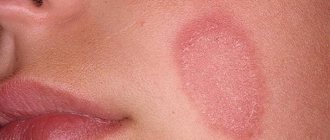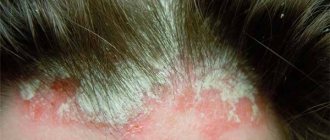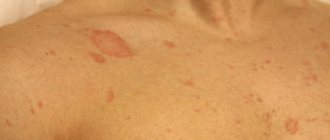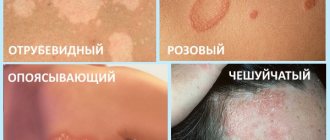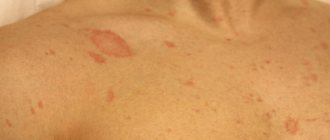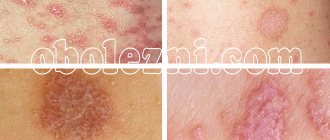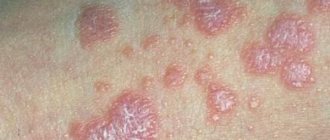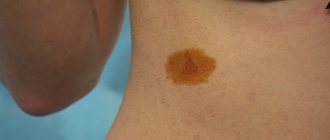Speaking about how lichen is transmitted from person to person, it is also worth remembering that this disease can be transmitted to humans from animals. The possibility of infection largely depends on the state of a person’s immunity, as well as on the type of lichen. As a rule, transmission is carried out by direct contact, through common household or personal hygiene items. Before you figure out whether lichen is contagious from person to person, you should understand what lichen is.
Pathogens and carriers of lichen
The content of the article
Dermatologists distinguish several types of lichen, caused by different pathogens.
Most often, the appearance of lichen on human skin is initiated by fungi:
- zooanthropophilic - transmitted to humans from an infected animal, including from pets;
- anthropophilic - live only on human skin;
- geophilic - live in the soil and come into contact with human skin upon contact with the ground.
In addition to fungi, viruses are often the causative agent of lichen. Their cunning lies in the fact that they can live asymptomatically in the human body for a number of years and become more active when the immune system is weakened. This is exactly how, for example, those familiar to many with herpes or shingles behave.
Types of disease and routes of transmission
So, we found out how you can get lichen, but how is it transmitted? The modes of transmission depend on the type of disease. Some forms are infected exclusively from humans, others from animals.
Generally speaking, infection occurs through direct contact with the source of infection or through personal belongings touched by the patient. Young children and people with weak immune systems are at risk. If everything is in order with immunity, then the likelihood of infection is quite small.
Note: the most common types of the disease include pink, ringworm, herpes zoster and pityriasis versicolor.
Ringworm
The most common type of pathology. It is highly contagious. The development is caused by the fungus trichophytosis and microsporia. People become infected first when they come into contact with a sick person. The second is most often transmitted from homeless animals.
Main symptoms:
- Foci of hyperemia appear with uneven edges, peeling is observed in the middle of the spot, and there is a specific edging - small bubbles.
- Hairs fall out in the center of the pathological element.
- Areas of alopecia appear on the head.
This form is transmitted quickly. A healthy person is strictly forbidden to touch the affected areas of a sick person, carry personal belongings of an infected person, or have close contact - kissing, hugging.
Pink
This form of the pathological process is accompanied by the appearance of small flaky spots of a round or oval color. They can be pink or brown. The causative agent is a viral infection, the nature is infectious and allergic. In medical practice, the disease has another name - the Zhiber virus. Pathogenesis has not been established. Some doctors claim that the herpes virus leads to the development of the disease.
At the moment, there is no exact data on the degree of contagiousness of the pathology. Doctors note that, in comparison with other varieties, pityriasis rosea is quite safe in this regard.
Fact: Members of the same family rarely get pityriasis rosea. If this happens, then the etiology is due to genetic predisposition.
The decisive factor in infection is the state of the human immune system and central nervous system. It is noted that with strong emotional lability, nervousness and other similar conditions, clinical manifestations intensify.
Infection occurs through the patient’s belongings - comb, towel, bed linen, clothing, other household items - mobile phone, computer, etc.
Shingles type of disease
This species is highly infectious. The causative agent is the third type of herpes virus, which leads to chickenpox. The pathology spreads through the nerve roots, which leads to severe pain, especially at the site of the lesion.
Instructions for using Keto Plus shampoo and cheap analogues
Transmission of the virus occurs in the following cases:
- Contact between a sick and healthy person;
- Use of the same accessories.
You can become infected with shingles only during the period of active rashes on the human body. If the appearance of crusts is already observed, then the patient does not pose a danger to surrounding people.
Pityriasis form
The causative agent is yeast-like fungi that multiply in the epidermis. Spots of various sizes appear on the skin. They are yellow or brown, sometimes pink, and can itch and itch. This variety can last for years. Provoking factors include diabetes mellitus, increased sweating, seborrheic diathesis, vegetative-vascular disorders, and immunodeficiency. According to doctors, this form is not contagious.
Types of lichen
In order to cure lichen, it is not enough to make a general diagnosis. It is equally important to promptly determine the type of lichen, since each is characterized by its own symptoms and requires its own treatment.
Dermatologists distinguish the following types of lichen:
- shearer;
- encircling;
- pityriasis;
- pink;
- red flat;
- tubular;
- solar;
- scaly.
Only a competent dermatologist can draw a line between them and correctly prescribe a set of therapeutic measures. Therefore, under no circumstances should you self-medicate. The surest way is to go to the clinic at the first sign of deprivation.
Now about what changes in the skin should alert a person.
How long are different types of lichen treated?
Treatment of lichen is determined by the causative agent of the infection and provoking factors. The course of therapy may vary within the following limits:
- pink – 4-6 weeks;
- shingles – 1-2 weeks;
- red flat – 2-6 weeks;
- cutting – 2-12 weeks;
- pityriasis – 1-8 weeks;
- scaly – 6-8 weeks;
- nodular – 1-2 weeks;
- asbestos – 2-3 months;
- white – 5 days – 2 weeks;
- eczema – 2-8 weeks.
The duration of treatment for dermatosis also depends on the causes of development, the nature of the course, and the person’s immune status. Many of them can recur when immunity decreases.
Ringworm
The source of trichophytosis - this is the second name for ringworm - can be any of the fungi that primarily affects the hairy parts of the body (head and beard), neck, shoulders, face. The symptoms of this type of lichen are usually as follows: first, swollen pink or red spots with clearly defined edges appear, then the edges of the spots become covered with bursting blisters and an itchy crust, and finally, the center of the spot begins to peel off, and the hair in the affected area breaks off and thins.
Ringworm is diagnosed using a Wood's lamp. If the disease is confirmed, the patient - children often suffer from ringworm - is protected from contact with others and is prescribed complex therapy, including taking special tablets (for example, Terbinafine) and the use of antifungal ointments. In particularly difficult cases, it is possible to take hormone-containing agents that help stop the inflammatory process on the skin.
Incubation period of lichen in humans: description, features and recommendations
Ringworm is a very serious skin disease, which is most often characterized by the appearance of nodular formations that cause severe and intolerable itching. In addition, inflammation and tissue necrosis may appear. Therefore, it is very important to determine the incubation period of lichen in humans in order to promptly minimize the possible consequences of this disease.
Causes of lichen
The most common type is ringworm. The incubation period for lichen in humans can vary depending on many factors. Most often it ranges from several weeks to two months.
Usually this disease is transmitted from a sick animal or person to a healthy one. The most common method of transmission of the disease is through household contact. They also often become infected by touching sick animals, using objects touched by an infected person, or visiting shared spaces.
When an infected person or animal touches objects, particles of skin or hair remain on them. They can remain viable for a very long time. The result can be epidemics, for example in schools and preschools. The highest risk of contracting lichen occurs in the spring and autumn months.
The most susceptible to infection with this skin disease are patients who have reduced immunity, who work with the earth without gloves, and who have cracks and microdamages on the skin. And also if they are in prolonged contact with sick animals or people.
Incubation period
The incubation period for ringworm in humans ranges from one to two days to one and a half to two months. The rate of development of this fungal infection directly depends on which pathogen is in the human body.
It's one thing if it's a superficial infection. In this case, the incubation period for depriving a person will be no more than a week. The first symptoms should appear on the 5-6th day after contact with the pathogen.
Ringworm of another type, for example infiltrative-suppurative, may not manifest itself even for several months. In this case, it is often not possible to determine when the infection occurred.
Symptoms of the disease
Ringworm affects any area of human skin, but most often the disease develops on the head. In this case, if the patient has a large amount of hair, the first signs of infection may go unnoticed.
You should be concerned if your hair begins to break and fall out for no objective reason. Peeling and unbearable itching also occur. The source of inflammation of the infection begins to appear 7-10 days after infection.
As a rule, after the incubation period of lichen in a person has passed, several foci of fairly large size form. A rash and suppuration forms around them. At the same time, the hair falls out even more, and the ends are covered with a characteristic gray coating.
If lichen appears on the human body, then it is even easier to detect it. Skin swellings appear on the back, arms, legs or chest; they can be pink or red in color.
If your nail plate is affected by fungus, it will eventually become cloudy, rough and rough, and even begin to crumble.
In the saddest case, with a chronic disease, the hair falls out greatly, noticeable bald spots form, and the itching does not stop. The shape of the spots can change, most often they emit a cloying odor.
With an infiltrative-suppurative form of infection, fever, weakness may develop, and lymph nodes will enlarge throughout the body. This form is also accompanied by migraine. This is one of the most severe forms. The number of lesions can be several dozen.
Transmission of lichen from animals
One of the most common ways to become infected with lichen is to catch it from animals. The carriers are often stray cats. Therefore, it is important to remember how shingles is transmitted. The incubation period for the disease is very long, and it can be very difficult to start treatment in a timely manner.
The symptoms are extremely unpleasant, and, as a rule, it is not possible to recover quickly and without consequences. Bald spots appear at the site of infection; severe hair loss is a prerequisite.
But you can become infected through any, even the slightest, contact with an animal. The main thing is not to mistake this disease for severe dandruff, but in the early stages they are very similar.
If you get carried away with dandruff treatment, you can seriously develop lichen.
The incubation period for lichen in a person infected by a cat can be several weeks. Therefore, it is best to completely avoid communication and contact with stray animals.
Or if you decide to take an animal into your home from the street, then before bringing it into your apartment, visit a veterinarian.
The specialist will be able to advise you whether the cat has lichen or other diseases, and will prescribe the necessary medications for both the animal and you and family members.
An extremely unpleasant disease is feline lichen. A person has a long incubation period, so the disease is usually started, and then they pay for a long time for their carelessness.
Treatment of deprivation
The goal of treating lichen is to destroy the causative agent of the disease. This is achieved using local therapy. It includes regular use of antifungal drugs; in especially severe cases, a specialist may prescribe special hormones that will help the body fight the virus. Multivitamins, iron and phytin preparations, and injections of aloe extract are also used.
At home, it is recommended to treat the affected skin with a 5% iodine solution and use antifungal creams and ointments.
Prevention of lichen
Ringworm is a disease that can and should be prevented. For effective prevention, it is necessary to regularly examine all family members for the appearance of the first signs.
A sick person must be immediately isolated and his belongings and belongings must be constantly disinfected.
After visiting public toilets and other places of public use, wash your hands thoroughly, take a shower daily, and do not use other people’s personal hygiene items – combs, underwear. Do not have contact with stray animals.
Source: https://FB.ru/article/277963/inkubatsionnyiy-period-lishaya-u-cheloveka-opisanie-osobennosti-i-rekomendatsii
Herpes zoster
It is caused by a virus that remains “dormant” in the human body for the time being. It appears in the form of fluid-filled blisters, usually located in the intercostal part of the body. Associated symptoms of herpes zoster: pain (caused by damage to the intercostal nerve endings) and itching of the skin in the affected area; sometimes fever with chills, headaches.
Treatment of herpes zoster is complex. Since the blisters of shingles burst, they are initially treated with brilliant green. And to lubricate the crust that forms in their place, use dermatol ointment. In parallel, the doctor may prescribe antipyretic, painkillers and antiviral drugs, quartz and laser therapy.
Pityriasis versicolor
It is also called multi-colored, because the small pink - and sometimes greenish - rash that appears on the back, stomach, shoulders, and chest changes color and turns brown as the disease develops. Moreover, on tanned skin (in summer) these spots appear discolored, but on white skin (in winter), on the contrary, they look quite dark.
Diagnosis of pityriasis versicolor can be carried out by a specialist who has resorted to microscopic examination of the dermis, Balzer iodine test, and Wood's lamp. He will also prescribe a special drug treatment (with the help of Orungal, Mycozolon, etc.) that can kill the fungus that causes the disease.
With proper therapy, pityriasis versicolor can be eliminated quite quickly (although without treatment, the disease drags on for many years). Additionally, the patient is recommended to adjust their lifestyle (a concomitant cause of this type of lichen may be increased humidity or air temperature), and carry out a complete treatment of clothing and linen.
Pityriasis (colored, sunny) type
Caused by pathogenic fungi. It usually manifests itself more acutely in the hot season (hence one of its names). Sweat is a favorable environment for fungal growth.
The symptoms of the disease are:
- small spots of various colors (pink, greenish, brownish), localized on the back, chest, abdomen;
- when scraping, small flaking scales resembling bran;
- discomfort is minimal: sometimes slight itching (but it may not exist).
Is lichen, or more precisely, a person suffering from it, dangerous for healthy people? There are different opinions regarding the contagiousness of this form: some believe that this disease is infectious, others are convinced that pityriasis versicolor is not contagious. Still, caution when communicating with patients does not hurt. Although this type of skin pathology does not seem to cause much damage to health, nevertheless, emotional and aesthetic discomfort is undoubtedly present both for the patient himself and for the people around him.
It can be treated quite easily, mainly with external means: Wilkinson's ointment, Andriasyan's liquid, salicylic-resorcinol alcohol. The People's Pharmacy recommends lubricating the lesions with fresh onion juice as a cure for sunburn.
Lichen rosea (or Zhibera)
A little-studied type of disease that usually develops against the background of a weakened immune system in the autumn or spring season. The risk group in this case consists of girls who have a hormonal imbalance in their body.
The manifestation of lichen is the appearance of round or oval pink and light brown spots on the chest, shoulders, back, sides, and skin folds. Dermatological changes, accompanied by itching and flaking of the skin, may go away on their own within a few weeks, however, when the first signs of the disease appear, it is recommended to consult a doctor to rule out the presence of syphilis similar in symptoms.
Prevention measures
In order to avoid infection with the virus, you must:
- eat right and strengthen your immune system;
- avoid contact with sick people;
- do not touch animals on the street, otherwise you must immediately wash your hands with soap;
- Pets need regular vaccinations;
- Do not use other people's hygiene products.
Ringworm is an unpleasant disease, but unfortunately common. It is often encountered by pet owners, but the pathology can occur against the background of other problems.
In order to overcome the disease, you need to consult a specialist at the first symptoms. Otherwise, the disease may develop into a chronic form and lead to complications.
Lichen ruber planus
Flat multi-colored (from pale pink to purple) nodules of lichen red often appear on the mucous membranes, nails (they crumble), and delicate skin of the chest and abdomen. Their appearance is accompanied by severe itching, which, as a result of scratching, leads to the rapid growth of foci of skin damage.
Dermatologists find it difficult to determine the cause of the appearance of lichen red, but note that it is quite common in patients with diabetes, as well as those suffering from diseases of the stomach, liver, and biliary tract. Moreover, women over 40 years of age are primarily at risk.
Tinea tubularis
Malasezzia is the name of the fungus that causes tubular lichen. This fungus can live in the human sebaceous glands for a long time without revealing itself in any way. Under certain conditions: for example, a decrease in immunity or an imbalance in the acid balance of the skin, severe hypothermia or excessive sweating, endocrine disorders or the development of certain chronic diseases - it begins to multiply intensively.
As a result, small flaky spots appear on the skin, which gradually grow and merge into one large spot. And although the victim practically does not feel itching or pain, he should not postpone a visit to the doctor.
After diagnosing the disease (methods used - scraping test, iodine test, use of a Wood's lamp, etc.), the dermatologist prescribes local or complex antifungal drugs.
Treatment
Therapy for deprivation is specific, requiring time and some effort. “If you find spots on your skin, you must go to a skin and venous dispensary. There they will take a scraping from the skin at the site of mushroom formation. If it is positive, take another culture. If the result is positive and the type of rash is determined, treatment is prescribed. They are discharged only after three negative test results.
Antifungal tablets are used as treatment, local treatment is the same ointments. Everything is very serious, it is difficult to treat, so you should prepare yourself for a long process,” warns the specialist.
At the same time, you should be wary of complications. “If left untreated and the spots touched or scratched, there is a risk of infection. Moreover, it will spread throughout the skin. But it’s mainly an external influence, it doesn’t have a systemic impact,” says Tatyana Egorova.
Ringworm solar
Under the influence of sunlight, excessive sweating, abuse of solariums and antibacterial agents, uneven, flaky dark spots may appear on the skin. Their occurrence is provoked by a fungus that multiplies on the dermis as a result of a violation of its acidity. Gradually, the spots grow to significant sizes, which causes aesthetic discomfort to a person: they clearly stand out against the tan. And although solar lichen is rarely accompanied by itching and pain, it requires mandatory therapy.
As a rule, solar lichen is diagnosed quickly: it is often enough to conduct an iodine test or use a Wood's lamp. At the initial stage of the disease, local antimicrobial drugs help well; in cases where the disease is advanced, the doctor prescribes complex therapy.
Ringworm scaly
The causes and treatment of this lichen, better known as psoriasis, are not fully understood. However, it is noted that it appears more often in people suffering from diseases of the endocrine and nervous systems and prone to alcoholism.
Psoriasis is a chronic disease, often occurring latently, i.e. is hidden. First, small reddish spots appear on the skin - most often the bends of the legs and arms, lower back and buttocks, causing severe itching due to dryness. Gradually, the spots grow and turn into a lesion that affects a large area of the skin. The peculiarity of psoriasis is that when the plaque is removed, the lichen begins to bleed.
It is necessary to treat scaly lichen under the supervision of a doctor, who will select the necessary topical medications (when applying them, you must strictly follow the instructions), and, if necessary, prescribe antibiotics.
How is the disease transmitted from person to person?
First of all, the degree of contagiousness of lichen depends on its variety and the human immune system. Often a person becomes infected through household conditions.
From a sick person to a healthy one
The pathology is viral in nature and therefore affects people with weakened immune systems. In view of this feature, experts gave the deprivation the degree of “conditionally contagious” disease.
The main routes of transmission from sick to healthy:
- using someone else's clothes;
- use of personal hygiene items;
- close contact (hugs, kisses, handshakes);
- public transport;
- through the fur of pets.
If the cause of lichen is a fungus, then infection can occur in the common use of a sauna, swimming pool or bathhouse.
From dogs to humans
This pattern is typical for ringworm. The disease often occurs in people who spend time with stray animals. To prevent the disease, it is necessary to limit “communication” with street dogs.
In sick animals, areas of the body are without hair, which is where the name “clipping” comes from. Parents need to monitor their children and explain to them that they should not touch street animals, especially if they are sick.
From human to cat and vice versa
As mentioned above, you can become infected with the ringworm form of the pathology from pets. This variety is considered the most acute. Very often, the disease affects a child’s body, since the immune system at this age cannot fully fight viruses.
Ringworm is transmitted in both directions. If a sick person comes into contact with a cat, it will also become infected.
It must be remembered that a cat that has suffered from shingles can remain a source of the virus for a long time. This is due to the fact that microspores remain on the wool.
Infection rarely occurs as a result of single contact with a sick animal. However, it is necessary to wash your hands every time after touching an outdoor cat or dog.
Is a person contagious during treatment?
The person remains infectious throughout treatment. That is why it must be protected from healthy people, provided with a separate room, dishes, personal hygiene products and household items.
Is it possible to get sick again?
Ringworm is a feature of weakened human immunity. Its nature is similar to the herpes virus, which is found in the blood of 90% of the population, but does not appear in everyone. Shingles can become a complication after ARVI or influenza.
Other types of the disease also tend to reappear. A person does not develop an immune response to lichen, so you can get sick more than once.
Are all types of lichen contagious?
Many people believe that absolutely all types of lichen are dangerous to others. Meanwhile, this is not entirely true. So, with pink, ringworm or shingles, the patient will really need to be isolated. But, for example, pityriasis or scaly ones are not dangerous for others.
And this is another reason why any change in the skin should be the reason for going to a specialist - only he will be able to correctly determine the type of lichen, assess the degree of its danger, give recommendations for treatment, and finally select a set of medications and therapeutic measures aimed at including general strengthening of the body.
If you find an error, please select a piece of text and press Ctrl+Enter
Causes
A person may develop lichen for the following reasons:
- Weak immunity, unable to cope with viral infection;
- Heredity;
- Transference of acute respiratory diseases, which, if complicated, can cause certain types of lichen;
- Contact with animals that are carriers of infection;
- A side effect of taking certain medications that cause disease, most often these include products for external use;
- Exacerbation of an allergic reaction;
- Frequent stressful situations;
- Damage to the skin that was not promptly treated with an antiseptic drug.
There are a large number of causes of the disease, most often depending on the type of lichen.

